Interview with V. D. Kekelidze by “Kommersant.Ogonek”
Interview, 11 September 2020
The “Kommersant.Ogonek” magazine published on its website an interview with interview with Vice-Director of the Joint Institute for Nuclear Research, Leader of the mega-science project NICA, Corresponding Member of the Russian Academy of Sciences V. D. Kekelidze. The interview was performed by the journalist Elena Kudryavtseva.
“The higher the energy, the closer we get to the beginning of the Universe”
A physicist Vladimir Kekelidze spoke about the chances of Russia in the world accelerator race
“Ogonek” Journal, issue No. 35, 07.09.2020, p. 28
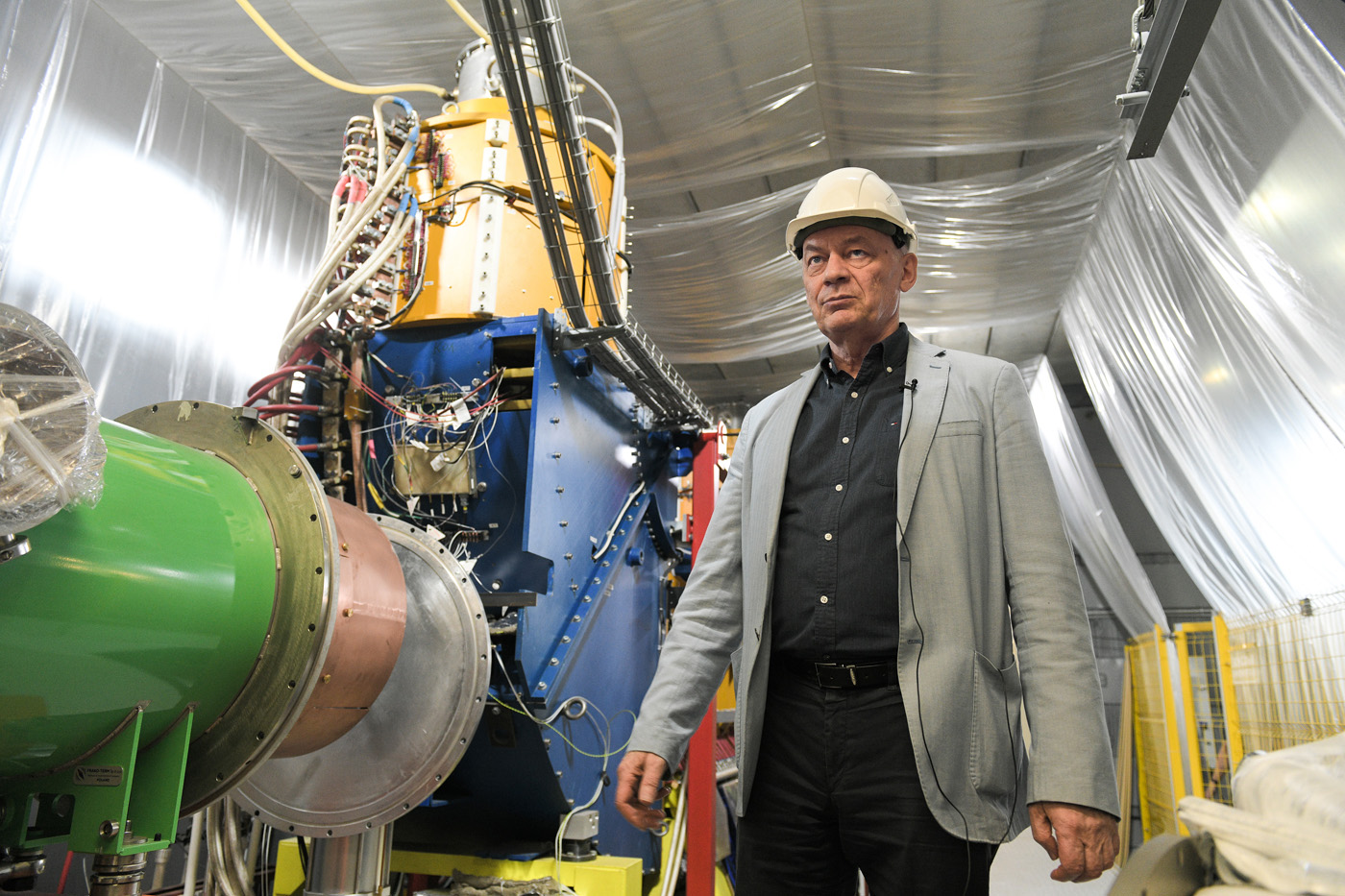 Photo: Evgeny Gurko, Kommersant
Photo: Evgeny Gurko, Kommersant
The new NICA collider (Nuclotron-based Ion Collider fAcility) in Dubna will soon start reproducing the first moments of our Universe. Director of the Veksler and Baldin Laboratory of High Energy Physics of the Joint Institute for Nuclear Research in Dubna Vladimir Kekelidze told “Ogonek” what are the chances of Russia in the international collider race, weather physicists will reach the antimatter trade or not, and how the freedom of quarks and the freedom of scientists are connected.
Interview by Elena Kudryavtseva– Vladimir Dimitrievich, the construction of the 500-meter ring of the NICA collider, which is, in fact, the first Russian mega-science project since the middle of the XX century, is coming to an end. What is the facility like?
– It is a collider of protons and heavy ions. It will be able to reproduce a special state of matter in laboratory conditions that possibly exists only in nuclei of neutron stars. Such facilities are called gigantic microscopes as far as they allow scientists to penetrate deeper and deeper into matter and to understand the structure of matter. They are also called time telescopes because the higher the energy in the experiment, the closer we get to the beginning of the Universe. We need to concentrate maximum energy per minimum unit volume to understand what was happening at that moment.
– It is not the first construction of world-level mega-science facility in Dubna. How was the place chosen for the Synchrophasotron’s construction? It is known that when scientists were looking for a place for the accelerator in Protvino in the 1970s, they visited 40 sites in search of a special rock. Is there some special soil, too?
– On the one hand, the rock provides stability to a facility. On the other hand, it transmits all the shakes from minor earthquakes and even from vibrations. So, there is another option: the accelerator should be put on a hard platform but in soft rock. The Synchrophasotron launched in 1957 in Dubna was relatively small and was constructed at a hard plate. At that time, it was the most powerful accelerator in the world, and today the Large Hadron Collider (LHC) at CERN, Switzerland, is the most powerful one. In the 1950s, it was designed for the energy of 10 gigaelectronvolts (1 GeV equals to 1 billion electronvolts, “O”). It was a significant milestone for humanity as far as after that it became possible to seriously study the structure of matter.
– Upcoming experiments at the NICA collider are not designed for such high energies as at the LHC where the energy is measured in TeV (tetraelectronvolts, or trillions of electronvolts). So, what is their uniqueness?
– The point is that scientists at the Large Hadron Collider study the processes occurring at extremely high energies.
Whereas the task of our collider is to create the maximum density of nuclear matter or, to be more precise, of baryonic matter. Baryons are, first of all, protons and neutrons, which make up the entire world around us. Once upon a time, at the beginning of the Big Bang, it had a zero density everywhere, and today, ordinary matter around us has a “solitary” (normal) density of baryons. This density can be much higher in the depths of neutron stars. Due to intense gravity, matter is so compressed that nucleons (protons and neutrons, “O”) in their nuclei penetrate each other and enter the state of quarks at some point. This phase transition will be studied at NICA. In fact, maximum densities possible to achieve in laboratory conditions on Earth will be created at the collider.
– What does it mean “maximum possible”?
– It means that it is impossible to create a state in which there will be more baryons per unit volume in laboratory conditions. In such a state of matter, we are dealing not with nucleons (protons and neutrons) but with quarks and gluons. To put it simply, each proton or neutron consists of three quarks.
To snatch quarks from a proton or a neutron, it is necessary to apply huge effort. The energy we are using in nuclear reactors and explosions is just the residual forces binding quarks inside the nucleon.
– Then how is it possible to extract quarks to observe this phase transition?
– We can either collide them or use the method based on a so-called asymptotic freedom principle. This significant phenomenon was discovered at the end of the last century. In 2004, David Gross, David Politzer and Frank Wilczek received a Nobel Prize for it. It turned out that if one tries to pull a quark out of the nucleon, then it is necessary, as I’ve mentioned above, to apply maximum forces known to mankind. But if quarks are brought closer to each other, then at some point, they stop interacting with each other, become free transforming into quark porridge, i.e. a quark-gluon plasma. Particles inside it stop moving freely, and when everything cools down, they unite into brand new nucleons and other particles.
– So, it is not accidental that David Gross came to Dubna when the first stone of the NICA collider’s foundation was laid. Did he want to see the place where quarks would be set free?
– Yes, he did come in 2016 and took part in the ceremony of the laying of the foundation.
– And how will you compress nucleons with such force without neutron stars?
– It is possible by accelerating and colliding two heavy nuclei of gold and gold, for example. However, if they are accelerated too much, as it happens in the Large Hadron Collider, the quark broth is formed but the density of baryons inside it is minimal. To achieve the desired effect, the energy should be about 10 GeV per nucleon. And we designed NICA with such parameters.
At the beginning of the beginning
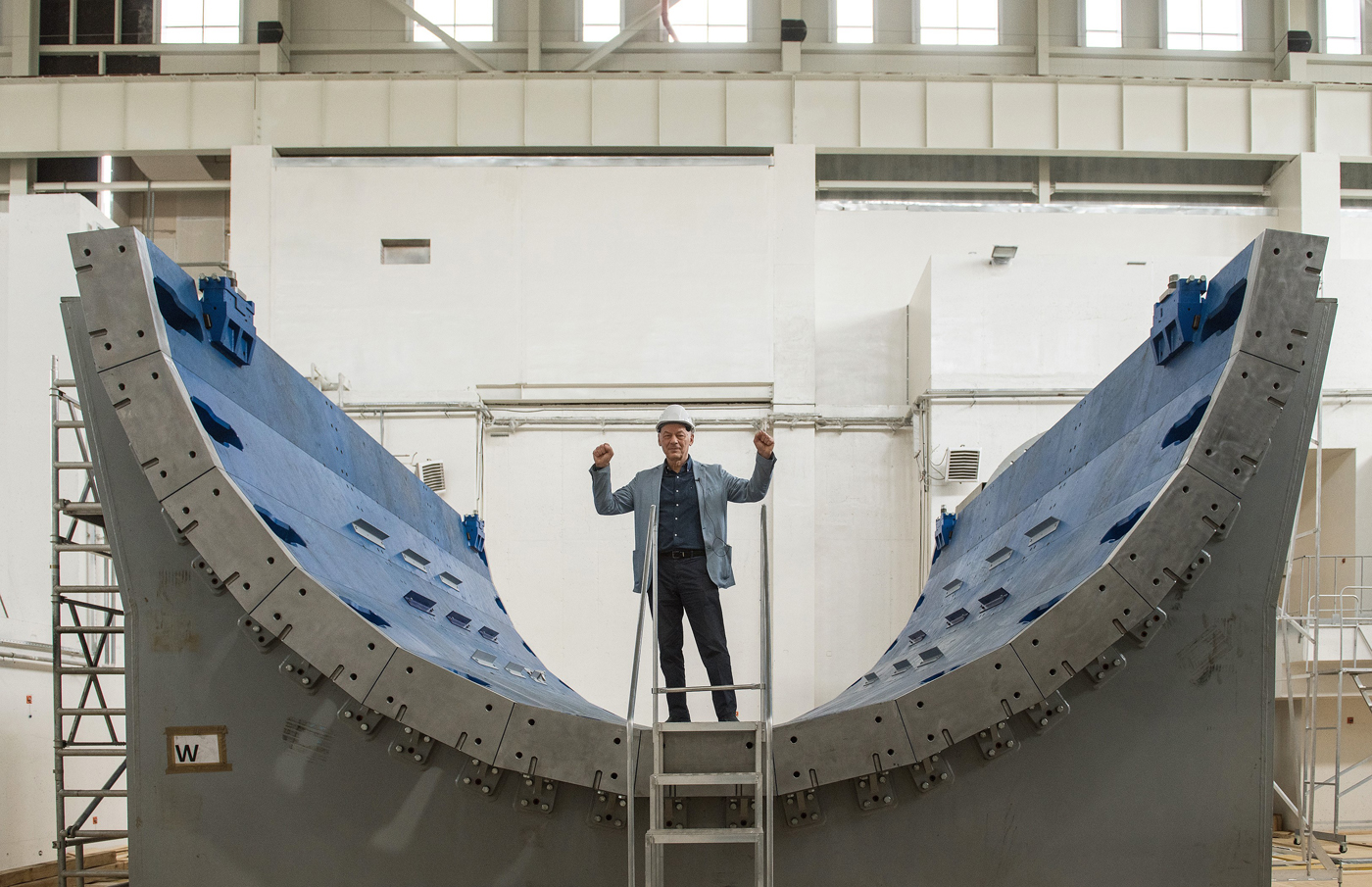 Vladimir Dimitrievich -Doctor of Physics and Mathematics, Professor, Corresponding Member of the Russian Academy of Sciences. Photo: Evgeny Gurko, Kommersant
Vladimir Dimitrievich -Doctor of Physics and Mathematics, Professor, Corresponding Member of the Russian Academy of Sciences. Photo: Evgeny Gurko, Kommersant
– What do we know about the beginning of the Universe when dense baryonic matter appeared? If there had been an observer, would they have seen a big explosion in all respects?
– In the first moment of the Big Bang there was no high density of the baryonic matter. There was high energy density. There was also matter and antimatter in equal volumes. All this expanded in space with an enormous speed creating complex fluctuations, which then became the basis for future stars and galaxies due to the theories of leading Russian scientists (for more information, read “Ogonek”, issue No. 11 2019). Another question is how matter emerged. It is one of the most fascinating tasks of modern physics. At some point, the balance between particles and antiparticles was upset. It was a very small difference from which our entire Universe was born.
Certain processes occurring in the Universe are responsible for the difference between matter and antimatter. These processes are impossible without violation of some symmetries, one of which is called CP-violation in science. In 1980, James Cronin and Val Fitch received the Nobel Prize for this discovery. They made this discovery in 1964 and first reported on it in Dubna in the same year.
– Why exactly did they do it in Dubna?
– Dubna hosted a so-called Rochester conference, the largest event in the fields of high energy physics. This conference is like the Olympic Games for physicists engaged in high energies. All brightest achievements of recent years are presented at the event.
It is extremely interesting to understand how quarks get free and then again imprisoned in cases when they are maximumly compressed. NICA will reconstruct this entire process: from the creation of the quark broth to the formation of new particles.
– Will it be possible to study antimatter in the same way? It is often written that it will cost serious money…
– Scientists at CERN study antimatter. They carry out very interesting experiments in which an antiproton is kept in a special trap. In fact, antimatter is created every day in experiments at accelerators and even as a result of natural processes, such as lightning. But it disappears fast in collisions with ordinary matter. For this reason, it is unlikely that it will be ever possible one day to produce antimatter in sufficient quantities.
– It is fascinating that your collider designed for fundamental tasks has an applied aspect as well. What is it?
– We proposed three innovative projects that may bring considerable benefit in the near future. The first one is related to irradiation of electronic circuits. The development of modern revolutionary electronics that will steadily operate under high radiation and cosmic radiation is impossible without it. It is necessary for space flights and other purposes. After all, even a single hit of a heavy ion in an electronic device may disable it. Failure statistics and the protection system will be developed using NICA.
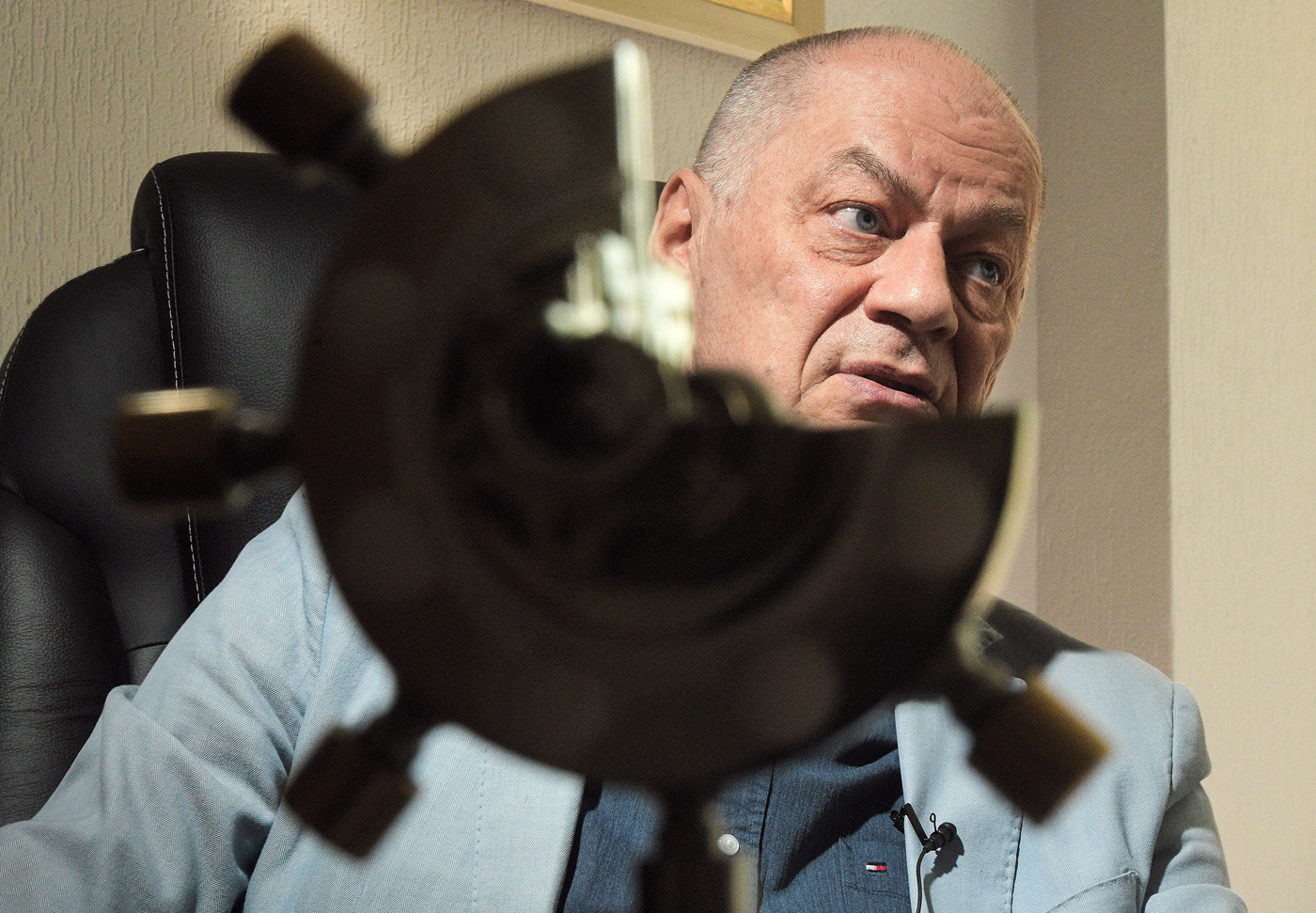 He has been working all his life in the fields of experimental particle physics trying to delve into nuclear matter. Photo: Evgeny Gurko, Kommersant
He has been working all his life in the fields of experimental particle physics trying to delve into nuclear matter. Photo: Evgeny Gurko, Kommersant
The second project includes the study of the effects of heavy cosmic radiation on living organisms. We conduct the same studies now, but the conditions for them are limited. Nevertheless, our colleagues from the laboratory of radiobiological research have already obtained very interesting results in experiments with monkeys. It turned out that after a slight radiation dose their cognitive abilities improved and then sharply decreased. It is vital for future human flights to Mars. Apparently, cognitive abilities and, by the way, vision will suffer the most during long flights. While it is possible to protect astronauts from charged particles by a kind of a protective field, it is not possible to protect them from neutral particles. You would not bring there large concrete blocks! That is why scientists have much to study in this field.
The third direction is related to medical technologies based on our magnets. It is a very promising field of activities related to the treatment of cancer.
– NICA is not the only project that studies quark broth?
– Yes, we have rivals. For example, the Brookhaven National Laboratory in the USA. They brought their collider into operation in 2000 and have already made several interesting discoveries when studied quark-gluon plasma. However, their baryonic density of matter is very law: initially, the project was designed for energies of 200 GeV per nucleon, and as I’ve already said, only 10 GeV is necessary to achieve the maximum baryonic density. In order to expand research in the fields of high baryonic density, they modified the collider’s design to lower the energy but it lost such an important characteristic as luminosity, i.e. the number of interactions per transverse centimetre per second. This parameter will ultimately influence the interaction statistics that is collected during the experiment and determines the accuracy of measurements.
We also have a rival that will start operating in 2025. It is the FAIR collider being constructed near Darmstadt in Germany. That is why it’s so important not to postpone the launch dates.
The Earth-size collider
– You have said that the largest experiments in the fields of high energy physics are currently being conducted at CERN. What is the main task physicists are going to solve and what will happen when the collider’s resources will be depleted?
– Nowadays, the LHC will study the Higgs boson in detail, and then a larger accelerator will be most likely constructed that will have several times higher energies than the existing one. The prospects for such a project are being regularly discussed at the meetings of the CERN Council uniting 23 countries. Every seven years, it prepares a strategic development programme. This time, it was decided to study opportunities for the project’s implementation, including geography, technological opportunities, and the cost.
– What will be the size of this giant?
– The diameter of the Large Hadron Collider operating nowadays is about 27 kilometres; the new collider will be about 100 kilometres large.
– It means that scientists will again face the protests of local people? They did not want to be near such a powerful scientific facility as the LHC.
– Yes, and there were unexpected conflicts, including legal ones. The existing collider is located in the territory of France and Switzerland. When a tunnel was dug for it, it turned out that laws differed in different places: somewhere the owner had the right only for the soil layer, and somewhere their rights extended deep into the centre of the Earth! In other words, you cannot just dig a subway line or something like this just under his feet. So, they had to conduct complicated difficult negotiations.
– Do scientists have a particular task for such a huge and expensive facility?
– The point is that there is still no particular physical aim, and it is very hard to move on without it. Nobody knows what energy is necessary to observe phenomena of so-called new physics (phenomena beyond the Standard Model accepted today, “O”). The LHC was constructed basing on the ideas about energies necessary to discover the Higgs boson, that is why everything worked out. The truth is that the supersymmetry theory was expected to be confirmed but it has not happened yet. And it is important for us to understand whether it exists in nature or only in minds of theoreticians. Moreover, it would be interesting to understand the nature of the quark: to find whether it is a point particle or it has a structure.
– Is there a limit to the development of accelerator technology? Or colliders will be grow in size forever?
– By and large, the limits are the Earth’s sizes and maybe even more.
The roads that we choose
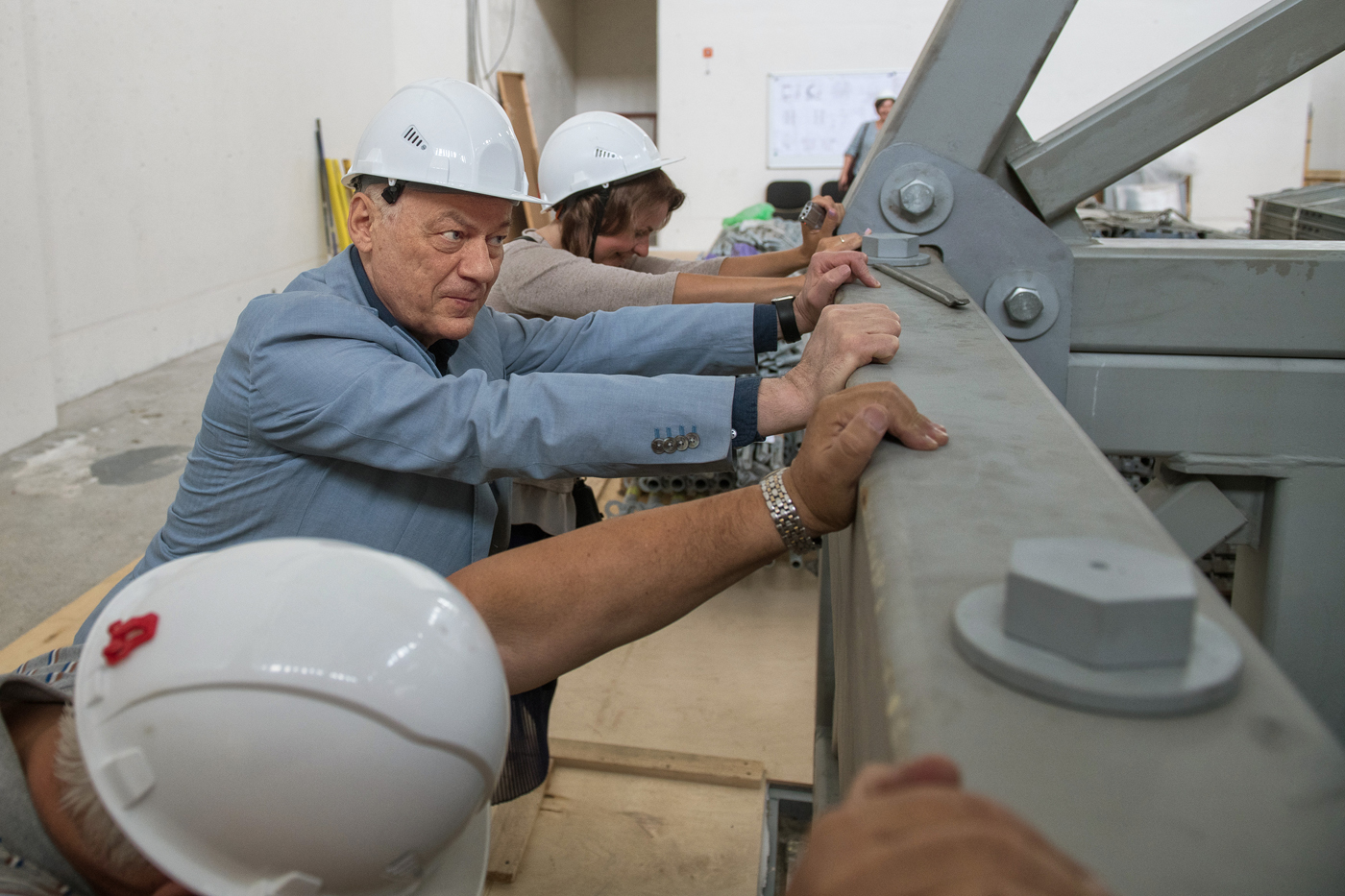 Largest megasience project in Russia, the NICA accelerator and experimental complex, was developed and is being created under his leadership. Photo: Evgeny Gurko, Kommersant
Largest megasience project in Russia, the NICA accelerator and experimental complex, was developed and is being created under his leadership. Photo: Evgeny Gurko, Kommersant
– How much has the pandemic extended the deadline for NICA?
– According to our estimations, for about six months as far as many activities conducted abroad had to be suspended. But we do not change our plans for launch at the end of 2022.
– What kinds of activities and where were they conducted?
– In Europe mostly. Now we are undergoing a very tough moment related to the delivery of the most important component of the MPD detector at the collider from Italy, namely the superconducting coil of the large analyzing magnet. This huge element with packing has the dimensions of 8 by 9 meters, weighs more than 70 tons, plus the double of the weight of the frame in which it is transported. It is a very sensitive cargo that should be transported observing all precautions measures, with shock sensors, etc. Such a facility can only be delivered by water. Our cargo was supposed to sail from Genoa where it was produced to Saint Petersburg, and to Dubna by a river barge along the Volga river. However, as far as it was impossible to work during the pandemic, the delivery time was shifted. And we should manage to deliver it before navigation closes on the Volga river. It is impossible to keep the coil in Italy until spring as far as it will cause the delay in the project’s implementation and additional large expanses. By the way, there are not so many companies able to do something like this.
– What is the main difficulty?
– It is a large magnet with the superconducting coil, which is supposed to create a highly-homogeneous magnetic field in a cylindrical volume with a diameter of 6 meters and a length of 8 meters. The coil is supposed to operate in the conditions close to absolute zero (minus 273,15°C, “О”). A Japanese “Toshiba” and ASG Superconductors in Italy produced such facilities for the Large Hadron Collider.
When we needed such a magnet, we decided to ask them to develop it because when constructing high-tech facilities, it is better to choose a company that has already produced such equipment. There are numerous negative examples in the world practice when a well-known company not experienced in the production of such complex equipment takes up this duty and then reports in several years that nothing is working out and scientists are back at the bottom of the ladder. That is why we chose the Italian company whose work was one and a half times cheaper than that of the Japanese one. And since we are talking about dozens of millions of euros, this is important.
– What is the most important thing in such a component?
– The quality of the magnet is determined by the quality of the magnetic field created by it. The field should be homogeneous enough as to make it possible to reconstruct the particle’s tracks in the detector with high accuracy. It is achieved by both the coil and the magnet yoke itself, iron which we had to make in another place as far as the Italians refused to do it themselves.
– Where did you get it?
– It is yet another very interesting story. The detector requires not cast but forged iron of excellent quality. We are talking about 9-meter long beams and rings 8-meters in diameter. A huge hammer is needed to forge them. It was believed that only the USA and China could do this, and Russia and Europe were not able to carry out this type of work. But we found a small company not far from Milan quite unexpectedly. They have a huge manipulator arm that can take a piece of iron with a weight of several hundred tons, put it on a hammer and then forge it.
We took iron blanks in Russia and preprocessed them in Novokramatorsk in Ukraine. Then we transported them to Italy and then to the Czech Republic for high-precision processing and assembling at a large factory specializing in making huge metal constructions, including gears for moving barges from one channel to another. Then everything was dissembled and transported here by 42 trucks. It is only one of the episodes of the large-scale project.
– So, you have to search for literally single specialists all around the world?
– There is no other way. If one lowers the bar for quality or responsibility in the creation of a unique project, they will never be able to achieve the required results. So, we only look for specialists doing exactly what we need, who are the best in the world.
– What does Russia do best in the world?
– Many things. For example, Budker Institute of Nuclear Physics in Novosibirsk makes the world best electron colling systems. All existing accelerators use their systems today.
Nobody produces fast cycled superconducting magnets better than in Dubna. World-unique production has been created in four years that assembles, tests, and certifies superconducting magnets for NICA and our rival partners FAIR. These are the key elements of our collider.
Science for everyone
– Is it possible to say who has come up with the idea of NICA? Whose ideas are the key ones?
– The idea to study nuclei collisions at these energies was proposed by Alexander Mikhailovich Baldin after whom our laboratory was named. He initiated the creation of the Nuclotron that operated since 1993 and that is now the basis of NICA.
In fact, the idea to study dense baryonic matter floated around by the beginning of our century. Many scientists from all over the world are members of the Scientific Council of the Joint Institute for Nuclear Research, so the idea has been developed in discussions with them. The birth of the project happed thanks to the discussions at the sessions of the Scientific Council of the Institute directed at that time by Alexei Norairovich Sissakian. He understood that we needed such a flagship project and made everything possible to initiate its implementation.
– I wonder why high-energy physics was a platform for active international communication from the very beginning. Even in the 1950s, at the height of the Cold War, our physicists visited national research laboratories of the USA…
– Because otherwise, it would not have developed. If one is confined in a country, a project will not work. There will not be enough education in all the required fields, technologies, knowledge, resources. To make something worthy, one should have a wide range of methods and technologies, educational specialists and even the variety of mindsets of the project’s participants. There are no countries able to say that it possesses, let’s say, 90 per cent of technologies in the field. JINR established in 1956 was not accidentally designed as an international organization. 12 member States joined the Institute at the beginning.
– It is not clear why China is not one of them.
– Originally, it was. However, in 1965, the Chinese Government recalled all its employees to the homeland within a few days because of political differences. Since then, the PRC has not been a JINR Member State. Nowadays, there 18 Member States and 6 Associate Members. By the way, in the 1950s, the Charter of our Institute was registered in the UN and is now stored in its Secretariat. It also helped us defend the Institute’s status in the complicated 1990s.
– It was the time when high energy physics, not a cheap scientific field, greatly suffered. The construction of the UNK collider in Protvino had to be stopped…
– Yes, and I find it a mistake. It was close to the modern Large Hadron Collider in terms of its scales. A lot of resources were invested in it; subway builders fully constructed a 20-km long tunnel; unique cryogenic technologies were developed, etc.
– Many Russian specialists went to work at CERN from Protvino.
– Yes, they did. But we are talking again about international cooperation in science. National projects of such scales were closed not only in our country. Around the same time, the construction of the larger SSC collider was stopped in Texas. In 1992, the Rochester conference was held right there. I remember a Texas taxi driver proudly telling me about the construction of a huge superconducting supercollider that would revolutionize world science. However, after several billion dollars already invested in the project, it was suddenly closed due to the disagreement between organizations of various levels. It badly affected high-energy physics, of course. In this regard, CERN is more stable as far as it has more than two dozens of countries as its members, and even if one of them decides to leave CERN, it will exist anyway.
Krypton and something else
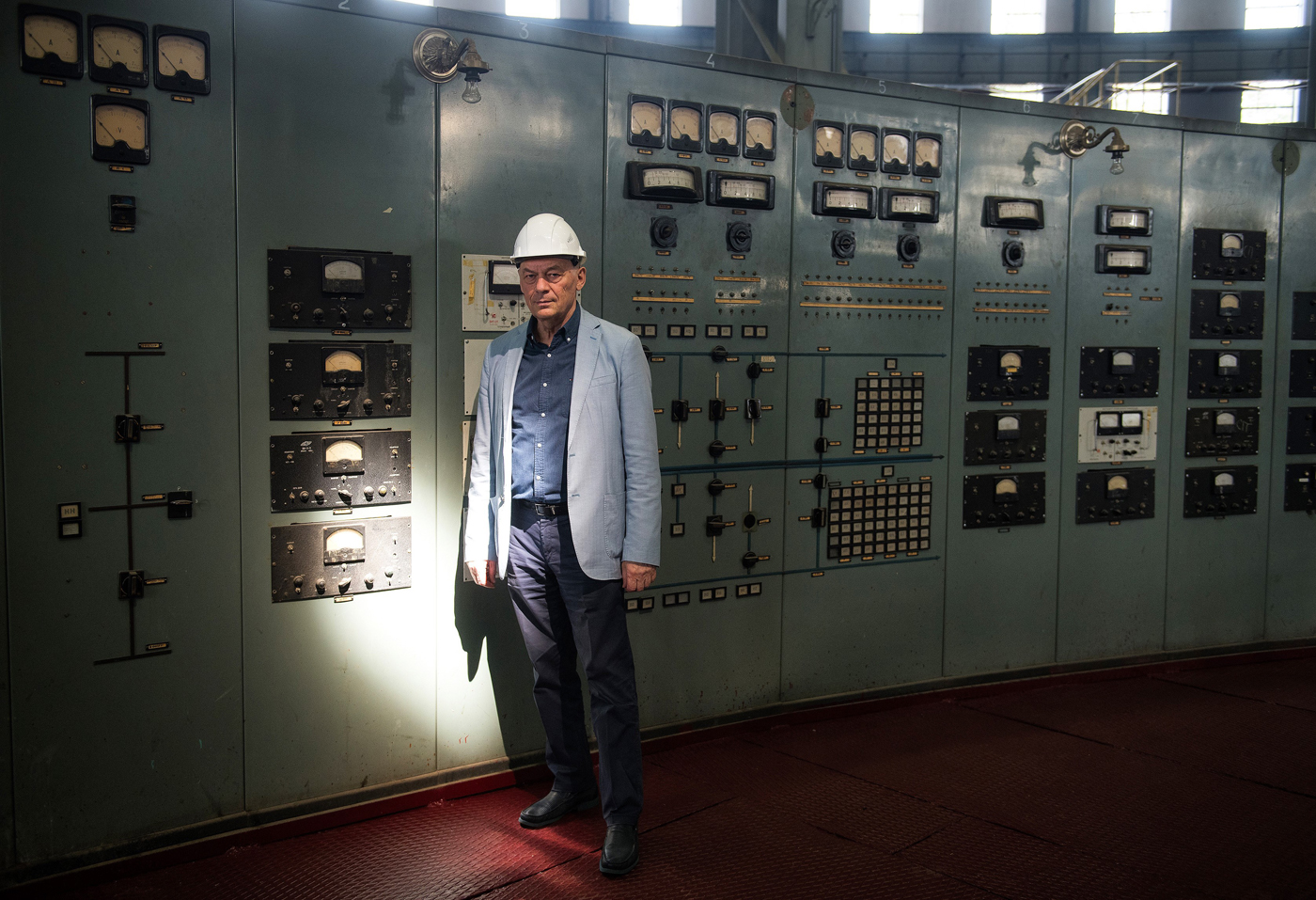 Since 2007 he has been Director of the Laboratory of High Energy Physics at JINR. Photo: Evgeny Gurko, Kommersant
Since 2007 he has been Director of the Laboratory of High Energy Physics at JINR. Photo: Evgeny Gurko, Kommersant
– You came to science at that difficult time. Did you want to leave the country in the 1990s?
– No, in those years, we were implementing a very interesting project in Protvino: we studied the production of charm particles at several facilities (quarks with a heavier mass, “O”) and tried to find new quark resonances.
Moreover, it was in the 1990s when the cooperation with CERN began in the frames of the NA-48 experiment in which the direct CP-violation was discovered with our participation. I have already talked about it today when explained the difference between matter and antimatter. Of course, participation in such a prestigious experiment was a matter of pride for any team. However, it was difficult to get involved in it. When I met the leaders of this project, we were offered to become participants of the experiment provided we would help create a liquid-krypton calorimeter. It is a unique device without which there would be no discoveries. A giant cryostat (tank) filled with liquid krypton is its basis. This device was necessary to register gamma rays from neutral pion decays.
– I am afraid many people today know only that Krypton is the home planet of Superman from DC comics…
– It is a chemical element with number 36. The difficulty was that 23 tons of pure krypton was necessary for the experiment, and this volume equals the world production volume. Krypton was a by-product of steel production and was used generally for light bulbs production. We needed krypton for a thorough cleaning. We applied to the Scientific Research and Design Institute of Energy Engineering (NIKIET) of the Ministry of Atomic Energy where specialists knew the gas purification technologies and asked them to help organize such production. A Dutch company financed (we are talking about millions of dollars) the plant. As a result, a factory for liquefied krypton purification was opened in a closed city not far from Yekaterinburg. The quality of the krypton exceeded the requirements of the experiment. We filled cylinders with acquired gas and sent it to Geneva by trucks.
After that, we produced an excellent cryostat made of aluminium at the best space enterprise in Russia, namely Khrunichev Space Center, at the expenses of the grant of the International Science and Technology Centre that financed conversion programmes in the CIS. And so we got an entrance ticket to the NA-48 project that is now in top-5 successful experiments at CERN. Young scientists from Dubna who took part in it immediately received work invitations all around the world. It was a perfect start for them. By the way, many young researchers come to Dubna nowadays for our project: we welcome about 40-50 students annually for internship and the competition is intense. Last year, there were many students from Poland. And we have recently signed contracts with five Mexican universities.
– Is it possible to say that the Russian school on high energy physics has been preserved?
– It’s hard for me to answer this question. The development of Russian high energy physics ended, by and large, when the UNK project in Protvino was closed. Since then, there were interesting studies but their scales did not reach the world level. That is why we are looking forward to the implementation of not only the NICA project but other Russian mega-projects as well. For example, the creation of the SKIF synchrotron in Novosibirsk. The fact is that large-scale scientific projects form a highly professional scientific environment: large teams of scientists, engineers, specialists. And if a country does not have its own projects and we work only at visiting experiments, then it is too early to talk about science revival…
Further republication of this interview including the photos is only possible in strict accordance with the JSC Kommersant terms of use.